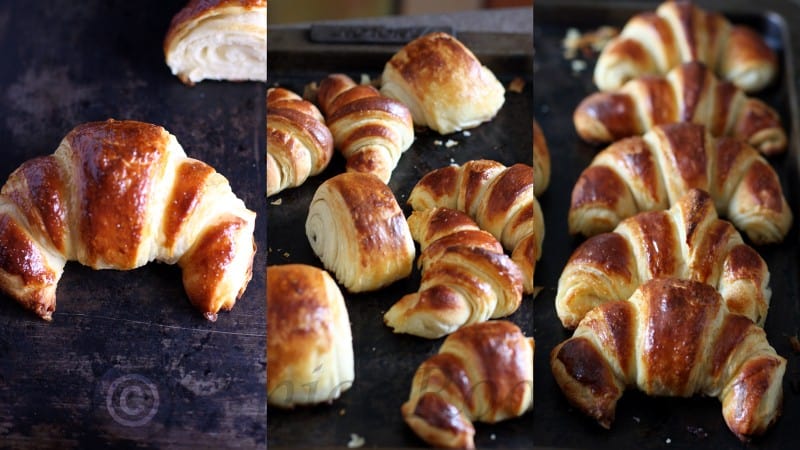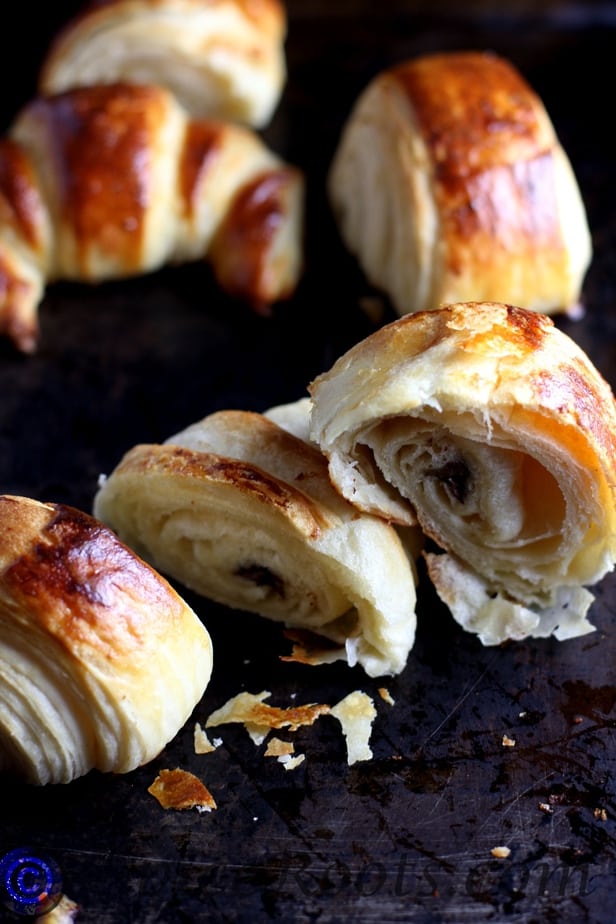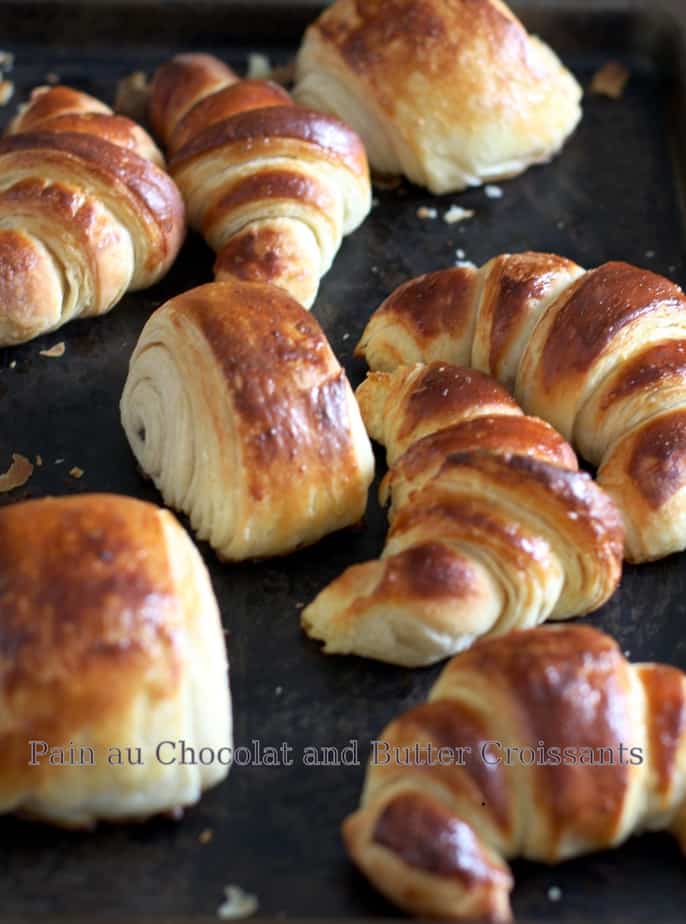
All Kinds of Croissants
The simple act of reaching out for a croissant, savoring its delicious layers, inhaling the deep aroma is a soul satisfying experience. Making a good croissant and sharing it recreates that experience and enhances it manifolds.
Flour, sugar, butter, milk, water, salt, yeast. That’s really all you need to make these fabled bites of a Viennoiserie goodness. The perfect crunch of top, the buttery layers inside and one little bite into it transports you to a place from where you don’t want to return.

Making a Croissant takes just two things – 1) Great quality ingredients 2) Love
To say that Croissants are a labor of love is to put it mildly. You wait for the dough to be just right, you check the temperature of the butter constantly, you laminate and freeze and then you keep an eagle eye on them while they are baking. And then you share them! My dears, the day you share a well made croissant with someone, it can only mean two things –
1) You love them – A LOT
2) 2) You are Enlightened and don’t worry about earthly things any more. There is no other reason you would share this with anyone.

Croissants from scratch is the second bread we are doing together as part of Project “We Knead to Bake”
Aparna provided us with a tried and tested recipe that really made our project easy. The detailed step by step instructions, worked like a charm. I would have liked to say that my Croissants turned out awesome the very first time, if I didn’t know for a fact that if Aparna had not taken the time and effort to make a Croissant making guideline, I would still have been looking for the perfect recipe.

The original source of the recipe was Jeffrey Hamelman’s classic croissant at Finecooking.com. There really isn’t anything much that I changed from Aparna’s recipe except that I had to use some extra milk to make the dough pliable, so I am taking the liberty and using her recipe in my blog post along with instructions. For a detailed understanding of how it all comes together, watch the audio tutorial on the Finecooking.com website. Also hop on over to Aparna’s blog for a detailed step by step instruction and do check Niv’s Blog for a panfusine version that she she named Pain au Poornam. Also check out this video to get a fair idea of what you are getting yourself into.
For more Croissant posts check out Aparna’s “We Knead to Bake “ and these croissants are also being Yeast spotted.

Croissants – We Knead to Bake
Ingredients
For the dough
- 4 cups all-purpose flour and a little more for dusting/ rolling out dough
- 1/2 cup plus 2 tbsp cold water
- 1/2 cup plus 2 tbsp cold milk [ I had to add two more Tbs]
- 1/4 cup granulated sugar
- 40 gm soft unsalted butter
- 1 tbsp plus scant 1/2 tsp instant yeast
- 2 tsp salt
For the butter layer
- 250 gm cold unsalted butter
For final egg/milk wash
- 1/4 cup of cold milk / 1 egg for egg wash / a mixture of 1/4 C powdered milk and a little water to brush on top of Croissants before baking
Instructions
Day 1
- Combine all the ingredients for the dough in the bowl of a stand mixer fitted with the dough hook. You can also use a food processor with the plastic blade, or do this by hand.
- Mix everything on low speed for 3 minutes, scraping the sides of the mixing bowl once if necessary. Then mix further on medium speed for 3 minutes. Lightly flour a 10-inch pie pan or a dinner plate. And place the ball of dough on this.
- Gently shape the dough into a flat ball by pressing it down before storing it in the fridge, this makes rolling out next morning easier. Lightly dust the top of the dough with flour and wrap well with plastic so it doesn’t dry out. Refrigerate overnight.
Day 2
Make the butter layer
- The next day, cut out 2 pieces of parchment or waxed paper into 10” squares each. Cut the cold butter into 1/2-inch-thick slabs. Place these pieces on one piece of parchment/ waxed paper so they form a 5- to 6-inch square. Cut the butter further into pieces as required to fit the square. Top with the other piece of parchment/ waxed paper.
- Using a rolling pin, pound the butter with light, even strokes. As the pieces begin to stick together, use more force. Pound the butter until it flattens out evenly into a square that’s approximately 7-1/2”. Trim the edges of the butter to make a neat square. Put the trimmings on top of the square and pound them in lightly with the rolling pin. Refrigerate this while you roll out the dough.
Laminate the dough
- Unwrap and lay the dough on a lightly floured work surface. Roll it out to a 10-1/2-inch square, and brush off the excess flour. Take the butter out from the refrigerator —it should be cold but pliable. If it isn’t refrigerate it till it is. This so that when you roll out the dough with the butter in ti, neither should it be soft enough to melt, or hard enough to break. Unwrap the butter and place it on the square of dough in the centre, so that it forms a “diamond” shape on the dough.
- Fold one flap of dough over the butter toward you, stretching it slightly so that the point just reaches the middle of the butter square. Bring the opposite flap to the middle, slightly overlapping the previous one. Similarly repeat with the other two so that the dough forms an envelope around the butter. Lightly press the edges together to completely seal the butter inside the dough to ensure the butter doesn’t escape when you roll out the dough later.
- Lightly flour the top and bottom of the dough. With the rolling pin, firmly press along the dough uniformly to elongate it slightly. Now begin rolling instead of pressing, focusing on lengthening rather than widening the dough and keeping the edges straight.
- Roll the dough into an 8” by 24” rectangle. If the ends lose their square shape, gently reshape the corners with your hands. Brush off the excess flour. Mark the dough lightly equally into three along the long side. Using this as a guideline, pick up one short end of the dough and fold 1/3rd of it back over the dough, so that 1/3rd of the other end of dough is exposed. Now fold the 1/3rd exposed dough over the folded side. Basically, the dough is folded like 3-fold letter before it goes into an envelope (letter fold). Put the folded dough on a floured baking sheet, cover with plastic wrap, and freeze for 15 to 20 minutes to relax and chill the dough.
- Repeat the rolling and folding, this time rolling in the direction of the two open ends (from the shorter sides to lengthen the longer sides) until the dough is about 8” by 24”. Once again fold the dough in thirds, brushing off excess flour and turning under any rounded edges or short ends with exposed or smeared layers. Cover once again with plastic wrap and freeze for another 15 to 20 minutes.
- Roll and fold the dough exactly in the same way for the third time and put it baking sheet. Cover with plastic wrap, tucking the plastic under all four sides and refrigerate overnight.
Day 3
Divide the dough
- The next day, unwrap and lightly flour the top and bottom of the dough. Cut the dough along the longer side into halves. Cover one half with plastic wrap and refrigerate it while working on the other half.
- “Wake up the dough up” by pressing firmly along its length with the rolling pin. Don’t widen the dough but simply begin to lengthen it with these first strokes. Slowly roll the dough into a long and narrow strip, approximately 8” by 22”. If the dough sticks as you roll, sprinkle with flour.
- Once the dough is about half to two-thirds of its final length, it may start to resist rolling and even shrink back. If this happens, fold the dough in thirds, cover, and refrigerate for about 10 minutes; then unfold the dough and finish rolling.
- Lift the dough an inch or so off the table at its midpoint and allow it to shrink from both sides and prevent the dough from shrinking when it’s cut. Check that there’s enough excess dough on either end so that when you trim the edges to straighten them, you have a strip of dough that is 20’ inches long. Now trim the edges so they’re straight.
- If you’re good at “eyeballing” and cutting the dough into triangles, then forget the measuring rule, marking and cutting instructions. Otherwise, lay a measuring rule or tape measure lengthwise along the top length of the dough. With a knife, mark the top of the dough at 5-inch intervals along the length (there will be 3 marks in all). Now place the rule or tape measure along the bottom length of the dough. Make a mark 2-1/2 inches in from the end of the dough. Make marks at 5-inch intervals from this point all along the bottom of the dough. You’ll have 4 marks that fall halfway between the marks at the top.
- Make diagonal cuts by positioning the yardstick at the top corner and the first bottom mark. Use a pizza wheel/ pie wheel or a bench scraper and cut the dough along this line which connects each top mark to the next bottom mark and then back to the next top mark and so on. This way you will have 7 triangles and a scrap of dough at each end.
Shape the croissants
- Now work with one piece of triangular dough at a time. Using your rolling pin, very lightly roll (do not make it thin but only stretch it slightly) the triangle to stretch it a little, until it is about 10” long. This will give your croissants height and layers. You can stretch it by hand too, but if you don’t have the practise, your stretching could be uneven.
- Using a sharp small knife, make a 1/2- to 3/4-inch-long notch in the centre of the short side of each triangle. The notch helps the rolled croissant curl into a crescent.
- Place the triangle on the work surface with the notched side closest to you. With one hand on each side of the notch, begin to roll the dough away from you, towards the pointed end.
- Flare your hands outward as you roll so that the notched “legs” become longer. Roll the triangle tight enough but not too tight to compress it, until you reach the “pointy” end which should be under the croissant.
- Now bend the two legs towards you to form a tight crescent shape and gently press the tips of the legs together (they’ll come apart while proofing but keep their crescent shape).
- Shape all the triangles like this into croissants and place them on a greased or parchment lined baking sheet leaving as much space between them as they will rise quite a bit.
Proof the croissants
- Brush the croissants with milk (or a mix of water and powdered milk or an egg wash).
- Refrigerate the remaining milk/ egg wash for brushing the croissants again later. Place the croissants in a cool and draft-free place (the butter should not melt) for proofing/ rising for about 1 1/2 to 2 hours. They might need longer than 2 hours to proof, maybe as much as 3 hours, so make sure to let croissants take the time to proof. The croissants will be distinctly larger but not doubled in size. They’re ready if you can see the layers of dough from the side, and if you lightly shake the sheets, the croissants will wiggle.
Bake the croissants
- Just before the croissants are fully proofed, pre-heat your oven to 400F. Brush the croissants with a second time, and place your baking sheets on the top and lower thirds of your oven.
- Bake them for about 15 to 20 minutes till they’re done and golden brown on top and just beginning to brown at the sides, turning once while they are baking. Cool the croissants on the baking sheets on racks.
- Best Served warm

